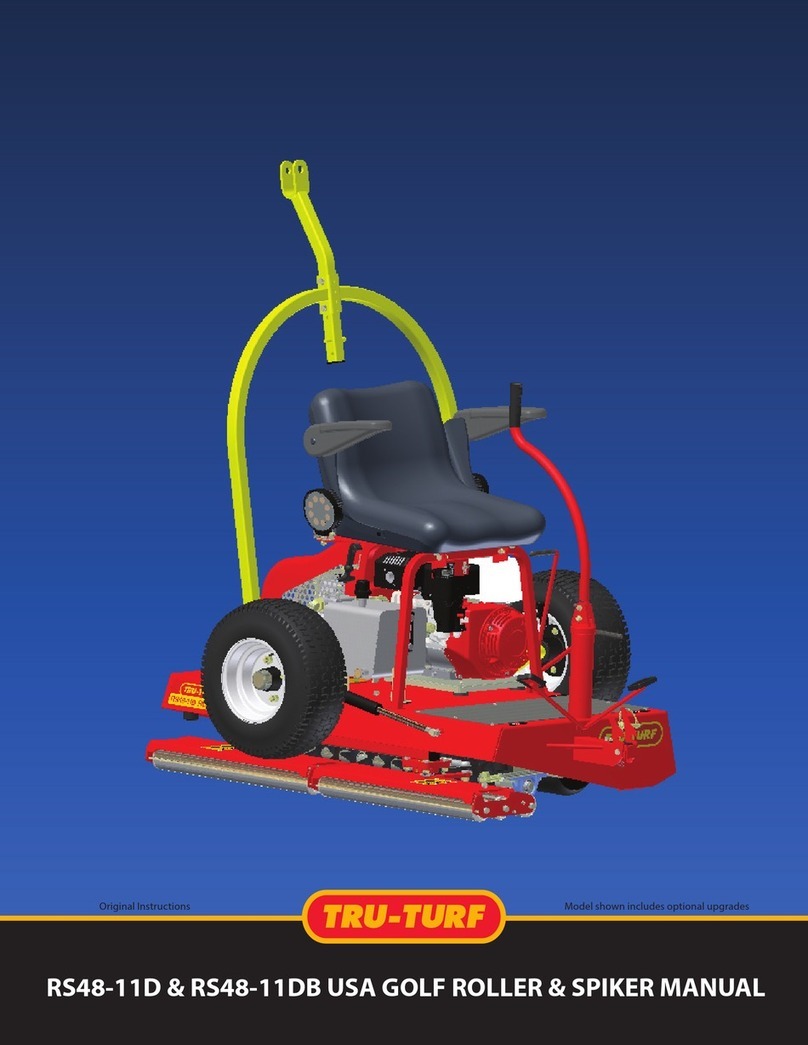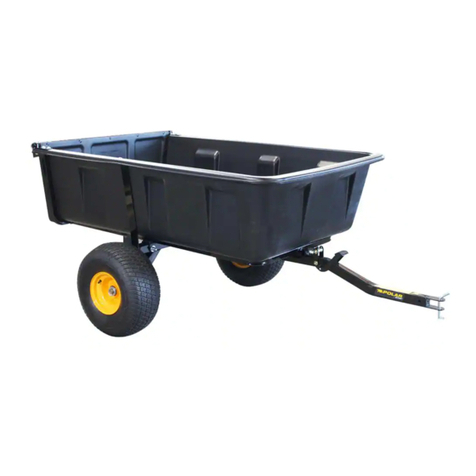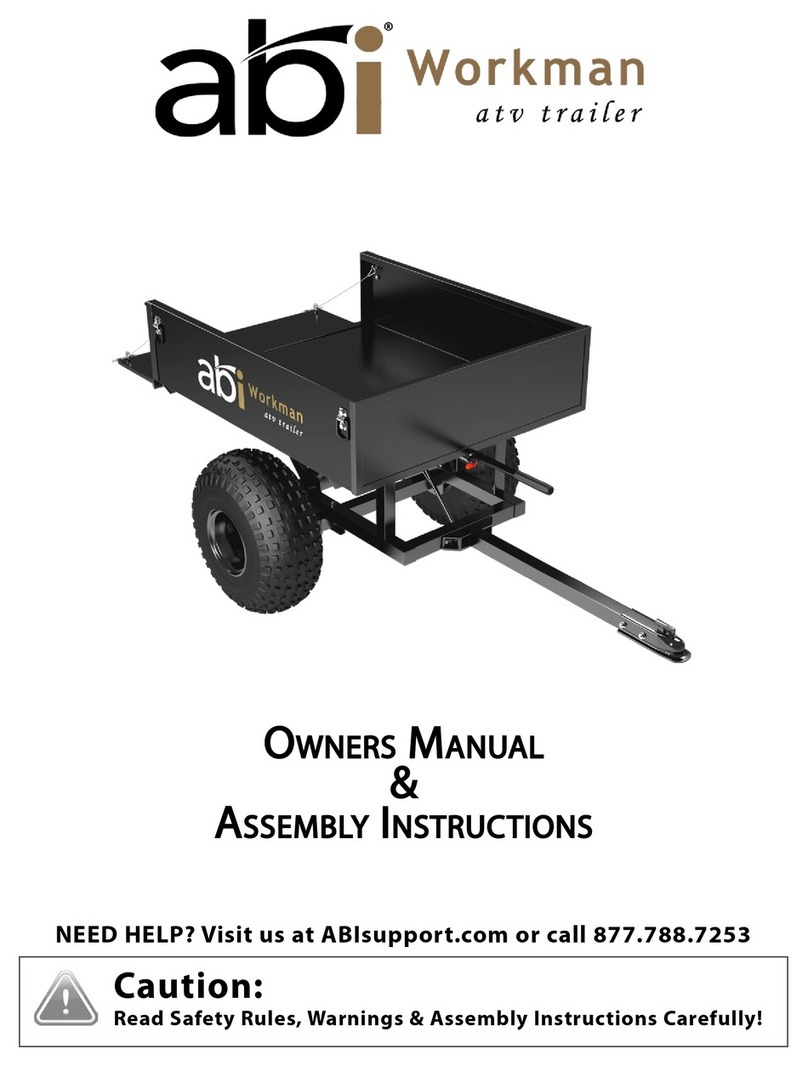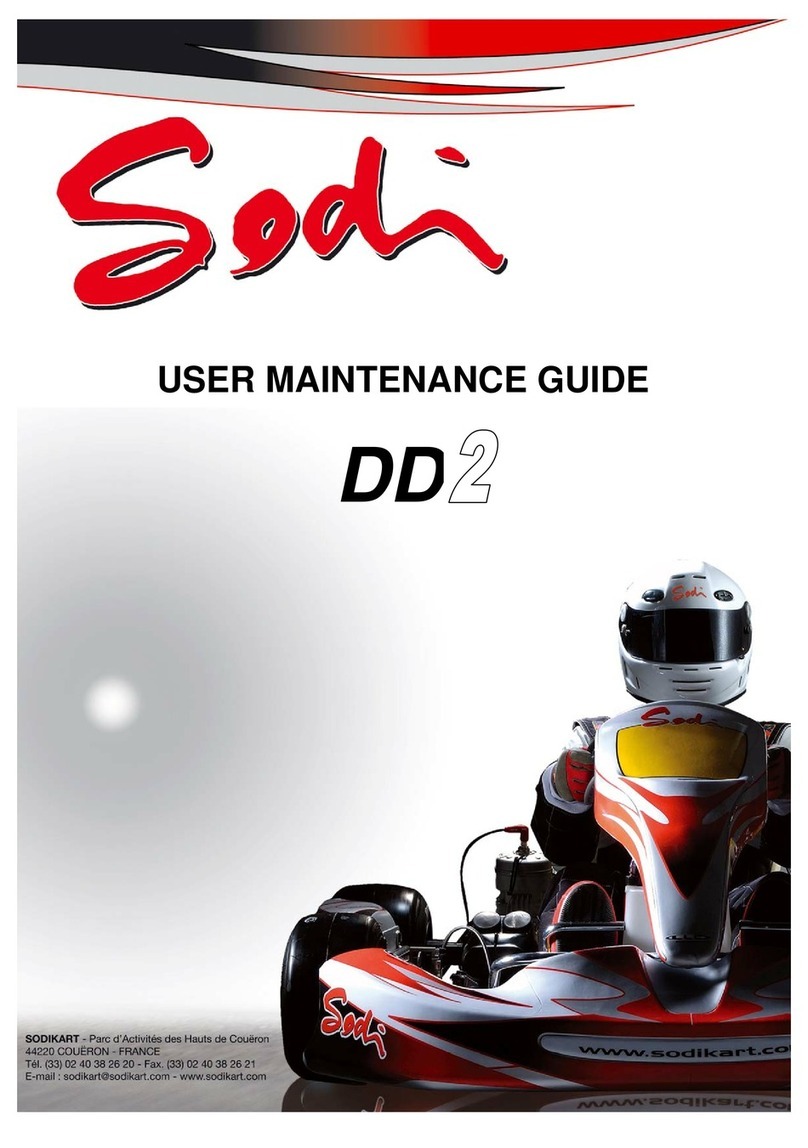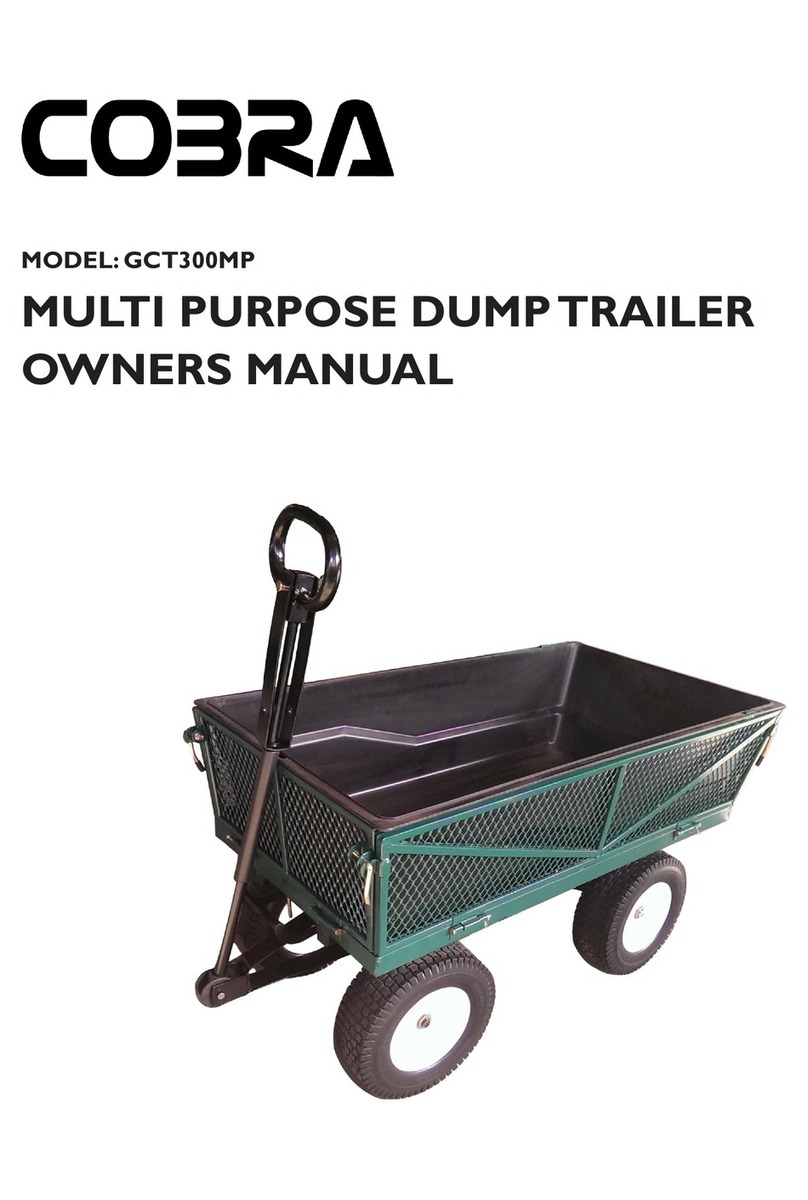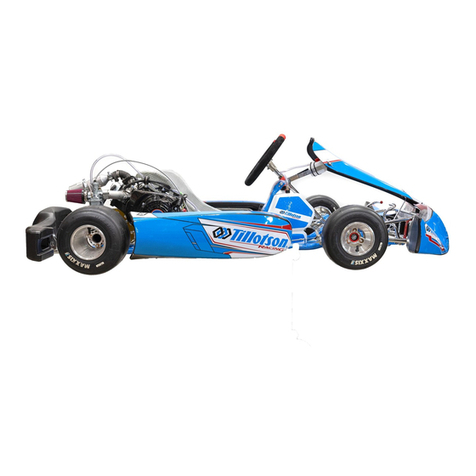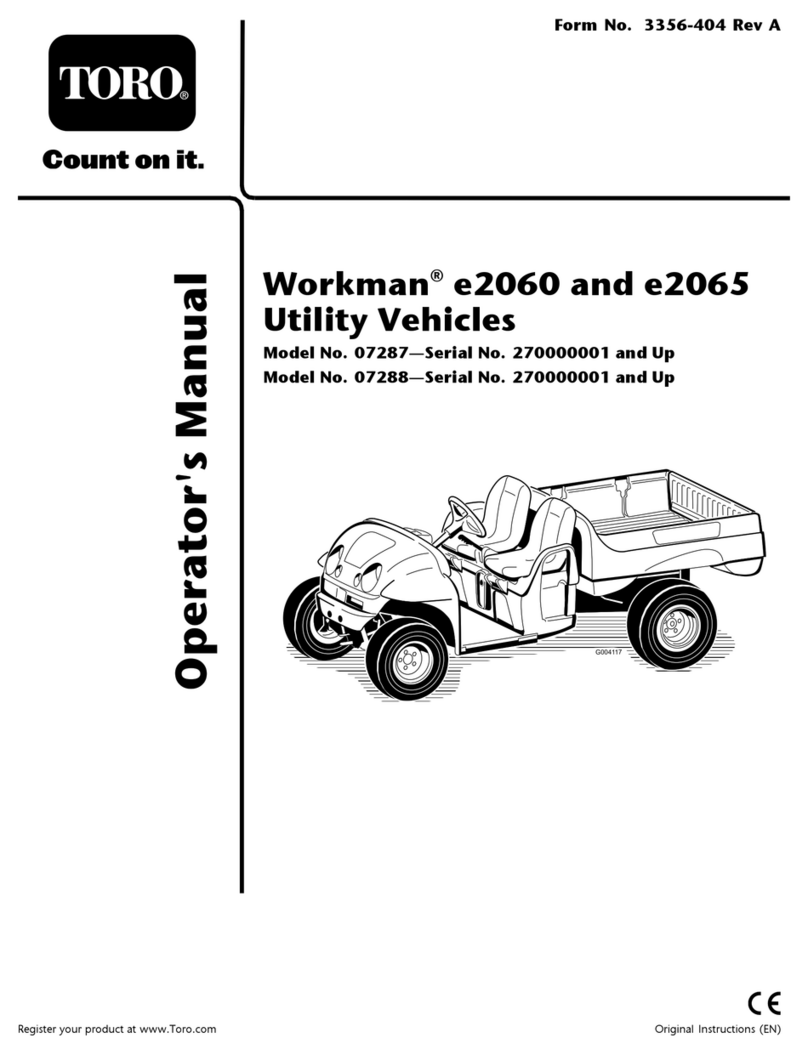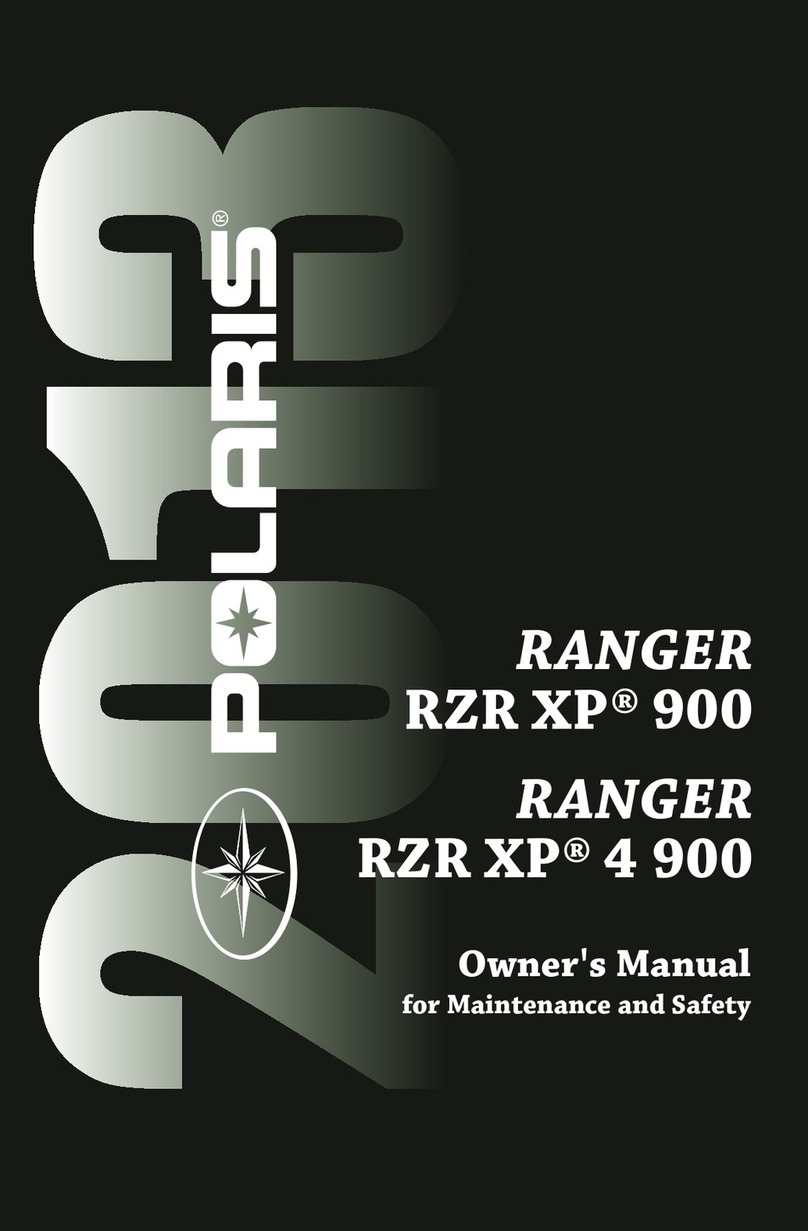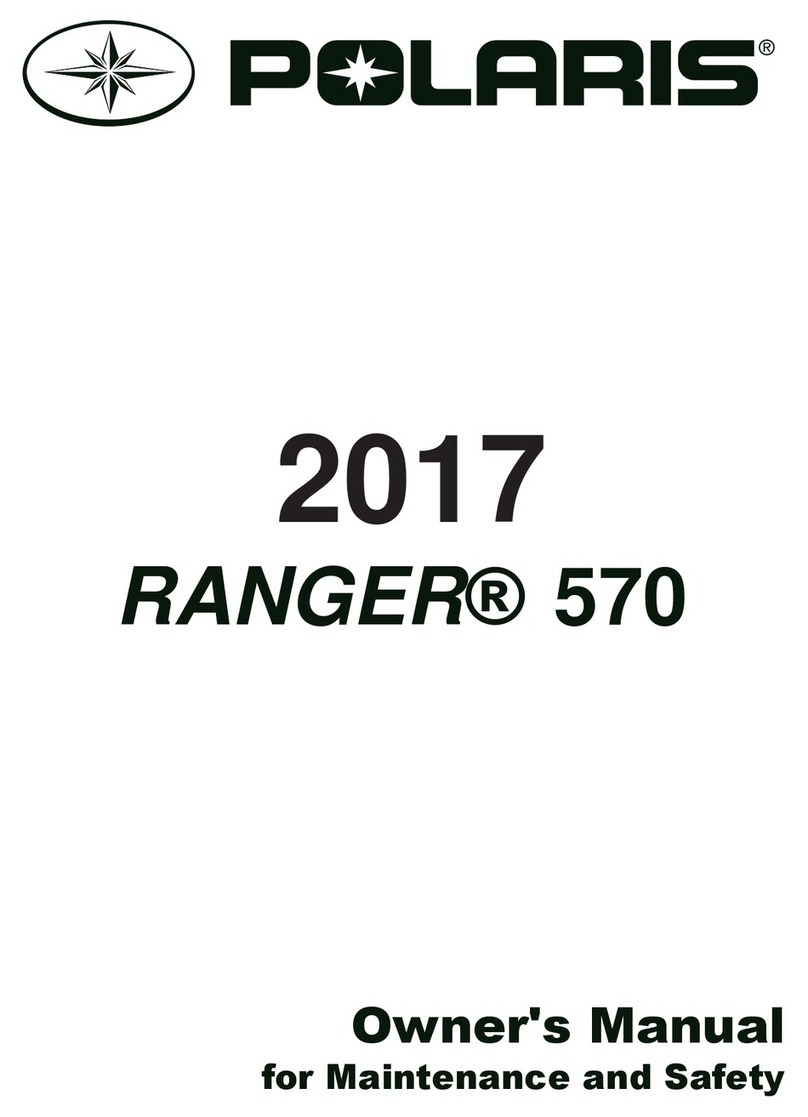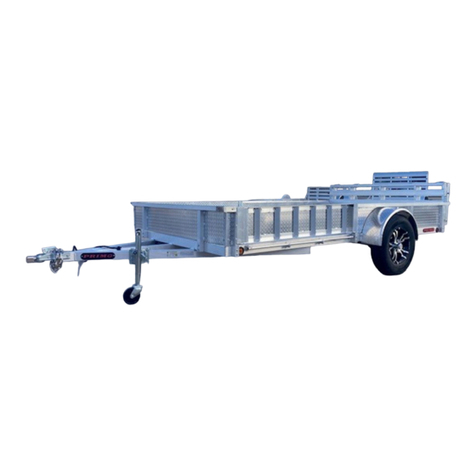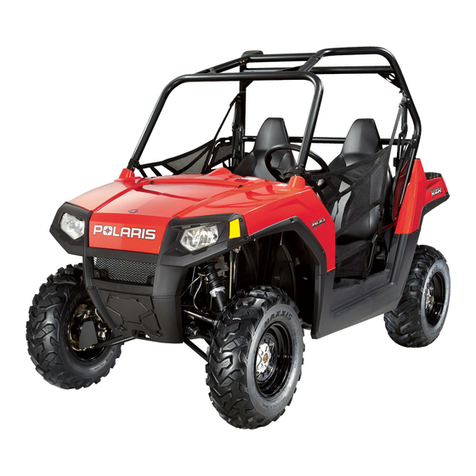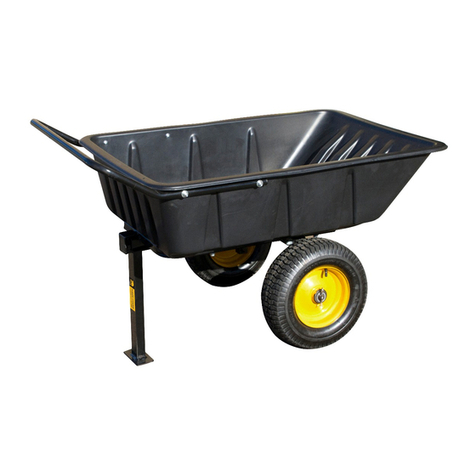Nimos Micro-Trac User manual

Micro-Trac
Transporter
Versie 0402 Micro-Trac Englisch
Read and save this book !
Users Guide


Usermanual NIMOS Micro-Trac Page 2
Nothing from this document may be copied or printed or used in any other way without
written permission from the manufacturer of NIMOS products.
Dealer
Costumer
Serial no.
:_______________________
:_______________________
:_______________________

Usermanual NIMOS Micro-Trac Page 3
Introduction
In this operating manual we give you, the owner/user of the NIMOS transporter type Micro-Trac, the most
important prescriptions with respect to operation and maintenance.
You are strongly advised to read this entire operation manual before using the MicroTrac for your own and
others safety and the lifetime of your implement carrier.
Regarding safety rules we want to bring to your attention the chapters concerning safety, employment and
maintenance.
You will understand that we can not be hold responsible for damage caused by improper or incompetent use, or
when one does not follow the instructions of this manual.
The text below is used in this manual to warn you or to point at important matters.
)Danger! This means risk or unsafe use that can course death or serious injury.
)Beware! The user is reminded to problems that may course injury or damage tot the
machine.
The NIMOS-machines are manifactured and designed to costumer specification.
Trough to this proces it is possible that some parts of the machine discription are not exact related
to your machine.
You have to be aware of this.Your dealer can inform you what the differences are on your specific
machine.

Usermanual NIMOS Micro-Trac Page 4
Index
1Disciption........................................................................................................................................................5
1.1 GENERAL DISCRIPTION.............................................................................................................................5
1.2 USERS CONDITIONS .................................................................................................................................5
1.3 TECHNICAL DATES....................................................................................................................................6
1.4 TYPE PLATE.............................................................................................................................................6
2Safety instructions ........................................................................................................................................7
2.1 SAFETY FIRST:.........................................................................................................................................7
2.2 SAFE OPERATION.....................................................................................................................................7
2.3 SAFE MAINTENANCE ................................................................................................................................7
2.4 USE OF ENGINE HOOD ..............................................................................................................................8
2.5 INSTRUCTION FOR EMERGENCY SITUATION ................................................................................................8
2.6 DESCRIPTION OF SIGNS............................................................................................................................9
3Operation controls.......................................................................................................................................10
4How to use your machine...........................................................................................................................11
4.1 STARTING..............................................................................................................................................11
4.2 STOPPING .............................................................................................................................................11
4.3 DRIVING ................................................................................................................................................11
4.4 SPEED CONTROL:...................................................................................................................................11
4.5 BRAKE PADEL:.......................................................................................................................................11
4.6 PARKING BRAKE:....................................................................................................................................11
4.7 DIFFERENTIAL LOCK:..............................................................................................................................12
4.8 LOAD.....................................................................................................................................................12
4.9 TIPPING.................................................................................................................................................12
5Implements...................................................................................................................................................13
5.1 COUPLING .............................................................................................................................................13
5.2 DECOUPLING .........................................................................................................................................13
5.3 INSTRUCTIONS TOWING THE MACHINE......................................................................................................13
6Maintenance.................................................................................................................................................14
6.1 OVERALL MAINTANANCE INSTRUCTION ....................................................................................................14
6.2 DAILY MAINTENANCE .............................................................................................................................14
6.3 CLEANING .............................................................................................................................................14
6.4 MAINTENANCE DIAGRAM.........................................................................................................................15
6.5 INSTRUCTIONS FOR ADJUSTMENT............................................................................................................16
6.6 PARTS FOR MAINTENANCE .....................................................................................................................17
7Attachment...................................................................................................................................................18
7.1 HYDRAULIC DIAGRAM BASIC MACHINE......................................................................................................18
7.2 ELECTRICAL DIAGRAM (MACHINE)E-1.....................................................................................................19
7.3 ELEKTRICAL DIAGRAM HONDA ENGINE E-2..............................................................................................20
7.4 ELECTRICAL DIAGRAM(YANMAR)E2........................................................................................................21

Usermanual NIMOS Micro-Trac Page 5
1 Disciption
1.1 General discription
Producer of NIMOS products
DROST MACHINES B.V.
Postbus 96 3910 AB RHENEN - HOLLAND
Utrechtsestraatweg 204A 3911 TX RHENEN - HOLLAND
1.2 Users conditions
The NIMOS Micro-Trac is a transporter, which is specially developed for
horticultures, public gardens, cemeteries and market-gardeners.
The answer of NIMOS for your transport problems: the NIMOS Micro-Trac,
comfortable, good overlook, noiseless and very manoeuvrable.
Standard the Micro-Trac is equipped with progressive driving pedal.
Basically the Micro-Trac is equipped with an open control platform with extra
low step and a three-side tipping loading platform.
Optionally the machine can be equipped with front lift, hydraulic PTO with
different functions, etcetera.
Micro-Trac: high transport capacity in narrow areas combined to enlightening of the working circumstances.
The NIMOS Micro-Trac can be delivered with Two-cylinder-four stroke-gasoline engine, environment friendly,
meets the newest Californian Emission-standard (CARB). Fully hydrostatic transmission with high and low
speed with differential lock. Driving speed variable from 0 to 25 km/h. High load capacity: 1200 kg.
Your Micro-Trac Can be delivered with the following options
1. Low pressure tires with high flotation, especially for lawns.
2. Open control platform, second seat, top and cabin can be delivered.
3. Simple and light control.
4. Fully hydraulic steering.
5. Electrically controlled tipping platform;
6. PTO pump 21 l/min at 175 bar with quick couplings at the front and/or rear;
7. Front lift with single acting cylinder;
8. Double acting functions
9. Water installation;
10. Extra sides;
11. Trailer coupling;
For special wishes consult factory.

Usermanual NIMOS Micro-Trac Page 6
1.3 Technical dates
Type: Micro-Trac
Motor: oAir cooled HONDA Gasoline engine GX620, 2-cilinder 14,9 kW (20 hp) at 3600
rpm, 44,1 Nm at 2500 rpm.
oLiquid cooled Yanmar diesel engine 3TNE68 3600rpm 14,6kw(21,5hp)
Transmission: Fully hydrostatic driven, with one pedal operation for forward and backward driving
automatically control of engine Rpm
Brake system: oBrakes: hydrostatic en disk brake.
oParking brake: disk brake.
Speed: High speed: 0-25 km/h
Low speed: 0-13 km/h
Pumps: Hydraulics of the charging pump of the hydrostatic transmission hydrostatic
transmission.
Optional: extra PTO-pomp (5,8 cc. - 21 l/min at 3600 rpm.)
Steering: Hydraulics.
Steering circel: Outer diameter 2050 mm
Inner diameter 680 mm
Tyres: Front: 18x 9.50- 4ply.
Back: 23x10.50- 4ply.
Tyre pressure:
- minimum
- small load
- heavy load
front
1,0 bar
1,0 bar
1,0 bar
back
1,0 bar
1,2 bar
1,4 bar
Cabin: Control platform: open control platform with spring seat, weight adjustable.
Cabin with roof and front window, doors and heating optional.
Dimensions: - length
- wide
- height
2900 mm
1180 mm
1440 mm
Loading floor:(inner
space) - length
- wide
- height
1560 mm
1100 mm
300 mm
Tipping unit capacity: 0,52 m3
Wheel base: 1500 mm
Track wide: 845 mm
Total weight: 1700 kg
Loading capacity: 1000 kg
Machine weight: 700 kg (standard)
1.4 Type plate
Ident. nr.: serial number;
Type: type;
Bouwjaar: year of production;
Eigen massa: netto weight;
Nom. vermogen: maximum power;
Maximum massa: total weight;
Max. aslast voor: weight front axle;
Max. aslast achter: weight rear axle.

Usermanual NIMOS Micro-Trac Page 7
2 Safety instructions
2.1 Safety first:
WARNING! Hazards or unsafe use which COULD result in death or severe personal injury.
CAUTION! Hazards or unsafe use which COULD result in minor personal injury or damage to the machine.
IMPORTANT! Indicates that equipment or property damage could result if instructions are not followed.
NOTE! Gives helpful information.
2.2 Safe operation
¾Persons younger than 18 years, are not allowed to use the machine (according to country regulations).
¾Maintenance and cleaning is only permitted, when the engine is not running.
¾When leaving the cabin, one always needs to turn off the engine, engage the parking brake and take the keys
from the ignition lock.
¾Before coupling implements, one has to consult the coupling and operation instructions.
¾Take care that there are no people in the direct neighbourhood of the machine when tipping the platform and
steering with the carrier.
¾The maximal allowed transverse slope during operation of the machine is 15 degrees in both directions.
¾The driver needs to be well-informed about the operating and maintenance instructions of the machine.
¾Transport of passengers and animals in the tipping platform is prohibited.
2.3 Safe Maintenance
¾For the user of the machine it is only allowed to do daily maintenance. All the other services have to be don
by an authorised NIMOS dealer.
¾Service and maintenance is only save when the engine is not running and the parking brake is on. When
maintaining the driving system the front and back tyres have to be blocked to prevent the machine from
rolling.
¾Spare parts must have the same specifications as delivered by NIMOS.
¾In the engine compartment are several dangerous parts. Such as the, the radiator, the exhaust pipe. The
Fan of the cooling can run without notice. This can cause serious injury.
¾For maintenance it best to wait until the machine parts are could down.
¾Never use bare hands to close or prevent hoses from leaking. The
pressure of the hydraulic system can cause serious injury.
¾Repairs on battery are not allowed. Keep away from fire or smoking.
¾Only let the machine running when the area has good ventilation.
¾Always use the red safety pin with maintenance under the tipping box.
IMPORTANT! The responsibility for changes, respectively modifications of the machine is
not for the
p
roducer
,
but for the one who has carried them out.
)WARNING! One always needs to set the red safety leg during inspection, maintenance or repair under
the tipped platform to protect the platform against coming down.

Usermanual NIMOS Micro-Trac Page 8
2.4 Use of engine hood
Caution! When closing the engine hood.
¾Make sure the clamps are secure before driving .
¾When opening he hood use safety pin to block the cilinder.
2.5 Instruction for emergency situation
)Danger ! When the vehicle is about to tip over always stay on the seat and hold yuor self to the
steering wheel. Jumping of when tipping over can cause serious injury
)Caution ! When the safety cage of the cabin is damaged it has to be inspected by an authorised
NIMOS dealer or consult the factory..
Hot engine parts Beware rotating parts
Danger jamming Place red safety pin

Usermanual NIMOS Micro-Trac Page 9
2.6 Description of signs
meaning Were to find
Attention
Before using the machine read
manual On drivers platform
Danger
During filling reservoirs smoking
or open fire is not allowed. On filler cap of reservoir.
Warning
Passenger transport
prohibited On the back of the machine.
Caution !
Hot parts On different parts in the
machine
Keep away from rotating parts
when the machine is running Drive shaft and belts
Warning!
When platform is tipped place the
red safety pin.
Under the tippingbox

Usermanual NIMOS Micro-Trac Page 10
3 Operation controls
Nr. Description.
10. Drive pedal (forward/rearward)and speed control
11. Throttle lever36-9211
12. Lever high and low gearingdrawing
13. Parking brake70-0371
14. Differential lock pedaldrawing
15. Choke-button36-9134
16. Switch direction indicator35-2215
17. Switch horn35-2215
18. Brake pedal
20. Switch lighting35-6404
21. Switch alarm35-6418
22. Switch tipping platform35-6420
23. Switch windscreen wiper35-6402
24. Switch windscreen washer35-6422
25. Switch rotary beacon35-6418
26. Switch blower35-6418
27. Switch work lamp35-6418
29. Starting switch (key)b35-2242
30. Maximum engine temperature
31. Air filter Renew air filter and reset the switch.
32. Charging current No charging current. Stop machine.
33. Fuel Little fuel in the tank: fill tank.
34. Oil pressure.
35. Glowing Cold engine pre-heats till the lamp goes out.
36. Control lamp direction indicator.
39. Fusebox35-2247
39A. 10A (hydraulic)35-2241
39B. 10A (horn and rearward driving light)35-2241
39C. 10A (windscreen wiper and blower)35-2241
39D. 10A (direction indicators, radio)35-2241
39E. 10A (lighting R.)35-2221
39F. 10A (lighting L.)35-2241
50. Switch hydraulic PTO (SA/front)35-6418
51. Switch hydraulic DA (front)35-6422
52. Switch hydraulic front lift (SA)35-6420
55. Switch hydraulic PTO (SA/rear)35-6418
56. Switch hydraulic DA (rear)35-6422
57. Switch hydraulic rear lift (SA)35-6420

Usermanual NIMOS Micro-Trac Page 11
)IMPORTANT! Don’t change gears during driving. When shifting, move the lever cautiously in
the outmost position. When the lever is not well engaged, it can move to neutral
position, so the hydrostatic driving and braking will not function!
4 How to use your machine
4.1 Starting
¾Switch all hydraulic functions (switches 20 to 23, 44 to 45) off, move the speed control pedal (10) to the
neutral position and engage the parking brake (13).
¾Read also the operation manual engine for further instructions.
¾Check if the warning lamps of the charging current (32) and the oil pressure (34) light when you turn the key
(29) to ON position and the engine doesn't run.
¾GASOLINE:Move throttle lever (11) to medium position, and pull choke out if starting a cold engine and start
the engine. Push choke in immediately after starting.
¾DIESEL:Move throttle lever (11) to medium position, turn key to PRE-HEAT position and hold until lamp (35)
goes out and start the engine.
¾Allow engine and hydraulic oil to warm up for a few minutes with throttle lever in medium position. Move all
cylinders totally in and out before you go driving.
4.2 Stopping
¾Switch all hydraulic functions off, engage the parking brake, shut off the engine and remove the key.
4.3 Driving
Shifting high and low gearing
Low gearing: press the lever (12) to the left and move it into the lowest position. Use this gearing for driving over
beaten roads and with light load.
Low gearing: press lever (12) to the left and move it into the upper position. Use this gearing for off-road driving,
on slopes and at heavy load or with trailer.
Neutral position: when lever (12) is in the medium position, the transmission is shifted neutral. The hydrostatic
driving and braking don't function.
4.4 Speed control:
With the drive pedal (10) you control the driving speed together with the revolutions of the engine. Forward
kicking moves the machine forward. Backward kicking moves the transporter backward. In the neutral position
the machine brakes (working brake).
4.5 Brake padel:
Use the brake pedal (18) to stop the machine in a short time. This brake is emergency brake if the hydraulics
should fail.
4.6 Parking brake:
Press the brake pedal (18) full down and move the lever of the parking brake (13) down, so that the pedal is set
in the lower position. To disengage the parking brake, press the brake pedal (18) full down and move the lever
of the parking brake (13) upward.
)NOTE! Let the engine run after heavy load to cool the machine.

Usermanual NIMOS Micro-Trac Page 12
)IMPORTANT! Don’t steer your transporter while using the differential lock.
4.7 Differential lock:
The differential lock can be shifted during driving by kicking the pedal (14) in with your left heel. Use this when
one of the rear wheels is slipping or blocking.
¾The danger zone must be well survey able for the driver all the time. For good view, it is necessary that
windows and mirrors are clean and that the mirrors are well adjusted.
¾If machine stops going uphill, disengage PTO (attachments drive) and backup slowly. Look behind you before
backing up.
4.8 Load
On the type print you find the masses and allowed loads of your transporter. Take care that the maximum load
is not exceeded.
Spread the load equally in the platform and close all sides after loading. Ensure all sides are closed before
driving. Take care that during transport no load drops from the platform.
4.9 Tipping
Place the transporter on a flat and solid underground and check if the pins are put in at the good side of the
platform. Open the side before tipping.
Let the tipping platform lower before driving and shift the tipping switch (22) after lowering the platform in the
neutral position.
)CAUTION! The maximal allowed transverse slope during operation of the machine is 15% in both
directions.
)CAUTION! When tipping, one has to take care that there are no persons in the direct
neighbourhood of the platform, because there exists a danger of jamming during
lowering the platform.
)WARNING! Never tip sideways when extra sides mounted!

Usermanual NIMOS Micro-Trac Page 13
5 Implements
Before (de)coupling: stop the machine and disengage all hydraulic functions (switches 22 and 50 to 57).
Engage the parking brake. Read the manual of the implement carefully.
5.1 Coupling
¾Check if coupled implements don't endanger the stability of the machine. Here you will find the maximum
weights and dimensions:
frontlift rearlift
distance centre of gravity to centre front axle: 1000 mm. rear axle: 850 mm.
max. weight of implement 150 kg. 200 kg.
¾Extra implement pump supply’s 21l.min at 3600 Rpm with 175 bar of pressure
always check the required power of the implement
¾Bolt all pins and strips after coupling implements.
¾Clean dirty quick couplings before coupling.
¾Couple the lift cylinder to the Single Acting quick coupling (H).
¾Couple the swivel cylinder to the Double Acting quick coupling (DW / two couplings).
¾Couple the working hydraulics to the working quick couplings (EW / two couplings).
¾Lower coupled implements when you stop the transporter.
5.2 Decoupling
¾Place the implement on a flat and solid underground.
¾Decouple all hydraulic hoses.
¾Put protection caps and plugs in when the implements are decoupled.
¾Disconnect all pins and strips.
5.3 Instructions towing the machine
¾Shift the reduction in the rear axle in the neutral position (high/low gearing) (lever 12).
¾Use the parking brake (13) when you must stop.
¾Maximum speed at towing is 3 km/h.
)IMPORTANT! Don’t tip the platform backward when the rear lift is mounted!

Usermanual NIMOS Micro-Trac Page 14
)Beware! Check level of hydraulic oil with tipping cilinder down
6 Maintenance
6.1 Overall maintenance
If you maintain your machine in the proper way, it will be your help during a long life. Good maintenance spares
you costs of service and stagnation.
The maintenance intervals are mentioned in the chapter "Maintenance diagram". The items which have to be
carried out at every 10 and 50 hours, can be done by the driver (column 1 and 2). Remaining maintenance can
be done by an authorized fitter/NIMOS-dealer.
Contact your NIMOS- or engine dealer when you have troubles and need servicing, when you order parts, or if
you have any questions.
¾Maintenance and cleaning is only permitted, when the engine is not running.
¾The responsibility for changes, respectively modifications of the machine is not for the producer, but for the
one who has carried them out.
¾Tools are not allowed to remain in or on top of the machine. This may cause lasting damage to the machine or
be a danger to persons in the direct neighbourhood during start up.
¾The fitter needs to be well-informed about the operating and maintenance instructions of the machine.
¾Clean dirty quick couplings (hydraulics) and renew damaged or worn hoses.
¾Always use the instruction of the engine when you maintain the engine.
6.2 Daily Maintenance
Check on daily basis, before driving, the points below:
¾Engine oil;
¾Hydraulic oil;
¾Fuel level;
¾Koolant;
¾Damages on hoses;
¾koolingribs radiator en oilkooler;
¾Air filter;
¾Damages on parts of the machine;
¾Tire tension;
¾Lighting.
6.3 Cleaning
Shut down the engine and engage the parking brake. Take loose parts from the machine.
Mind cooling ribs of the engine, hydrostatic transmission and oil cooler (option). Clean mentioned parts
carefully.
)IMPORTANT! Never clean the ribs of cooler with water always use air cleaning in opposite direction.
)Danger! Always place the red safety pole during inspection, maintenance or repairs under the tipped
platform to prevent the platform from coming down.

Usermanual NIMOS Micro-Trac Page 15
6.4 Maintenance diagram
First Every Every
Frequency 10 hours 50Mhours 250 hours 500Yhours 5 years
fuel tank C
hydraulic oil tank / level V V
Battery liquid V V
parking brake V V
Neutral position transmission V V
lighting V V
instrument panel V V
tire pressure V V
hydraulic hoses (damage/leakage) V V R
clearance pivot frame (under steering
platform) and wheel bearings
V
Tighten wheel nuts V
hydraulic system V
Suction filter hydrostatic transmission RY
Suction filter gear pumpeC R
return flow filter element R
filling cap hydraulic tank R
hydraulic oil R
Driving pedal (1) G
propel shaft (1) G
ball joints tipping platform (4) G
Tipping cylinder mounting (5) G
hinge bonnet (2) G
hinge cabin doors (4) G
DIESELMOTOR Yanmar 3TNE68 (Always use manual of manufacturer)
1st Service
Frequency 50 our 1003M
our 2006M
our 400J
our 500 our 800 our 1000
our
Motor oil V V
V-belt C C V
oil filter V V
Fuel filter V
Air filter Clean with every service interval
Radiator R
cooling system C C
Valve clearance C
Nozzles C
Radiator hoses and fuel hoses V
Note! Maintenance can be carried out by: Driver 50 our interval
Other interval by authorised NIMOS dealer

Usermanual NIMOS Micro-Trac Page 16
Gasoline engine (follow the instructions of the manual of the engine when you carry out maintenance to the engine)
HONDA First Every
Frequency 25 hours 503M hours 1006M hours 200Yhours
engine oil R R
air filter C R
oil filter R
fuel filter R
cooling system C
spark plugs V
Mminimal every month 3Mminimal every three months
6Mminimal every six months Y
minimal every year
C = cleaning V = check
R = renew G = grease
e= Option;
6.5 Instructions for adjustment
Bolts must be tightened with the following tighten torques:
Function Torque Bolt Quality
Front wheels 117 Nm M12 10.9
Rear wheels 125 Nm M14 8.8
Pivot frame 280 Nm M16 10.9
Neutral position hydrostatic transmission: engage the parking brake and let the engine run. When you hear the oil flow
through the over-pressure valves (high sound), the neutral position doesn't function well.
Adjust the nuts at the stud on the cross-beam rear till you don't hear the above mentioned sound. Be sure the nuts are
tightened well to lock the setting.
When the machine drives forward, lengthen the screw thread. When the machine drives rear: shorten the srew thread.

Usermanual NIMOS Micro-Trac Page 17
6.6 Parts for Maintenance
Volume [L] Description
Motor oil Engine manual
15 W40
Cooling liquid Engine manual
Engine manual
Fuel 22,5 gasoline engine: Unleaded
dieselengine: diesel
Hydraulic fluid 12
with reservoir 45 Discription of oil on filler cap
o standard Total Equivis ZS 46
o Biological-oil: Total Hydro-bio 46 or Shell Naturelle
HF-E 46
Grease Multi Grease class 2 (DIN 51818)
G=Gasoline engine, D=Diesel engine.
)Beware! Never use different type of oil together
Part description Yanmar LDW 702 Kubota 722 HONDA
Engine oil filter 1 20-0917 20-0906 20-0915 20-0913
Air filter element 1 20-0640 20-0630 20-0631 20-0651 (big filter)
20-0654 (small filter)
Fuel filter element 1 20-1220 20-1206 20-1218 20-1224
V-belt 1 20-1554 20-1512 20-1511
Distribution belt 1 20-1540
Suction filter driving
pump 1 08-1897
Suction filter 1 08-1803
Return filter element
(hydraulics) 1 08-1830
Verstelling neutraalstelling

Usermanual NIMOS Micro-Trac Page 18
7 Attachment
7.1 Hydraulic diagram basic machine

Usermanual NIMOS Micro-Trac Page 19
7.2 Electrical diagram (Machine) E-1
Table of contents
